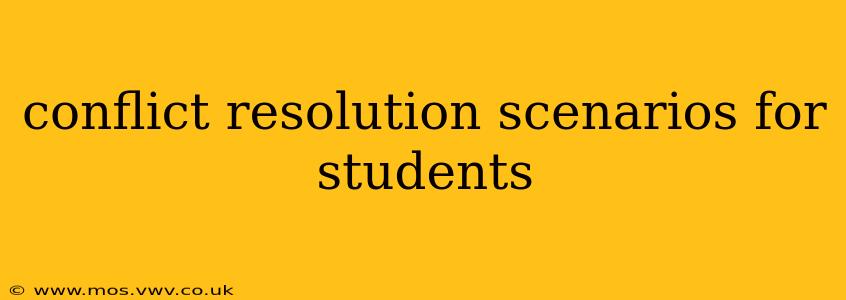Conflict is an inevitable part of life, and learning to resolve disagreements constructively is a crucial life skill. This article explores various conflict resolution scenarios relevant to students, offering practical strategies and insights to help them navigate challenging situations effectively. We’ll cover scenarios ranging from minor disagreements to more serious conflicts, equipping students with the tools to become effective communicators and problem-solvers.
Common Conflict Scenarios in Schools
Students face a range of conflicts, from small misunderstandings to larger disputes impacting their learning and well-being. These can include:
- Disagreements over group projects: Sharing workloads, differing opinions on approaches, and unequal contributions are common sources of friction in group projects.
- Bullying and harassment: This serious issue requires immediate intervention and understanding of its various forms, from physical to cyberbullying.
- Classroom disruptions: Students might clash over attention-seeking behaviors, disruptive talk, or disagreements with classroom rules.
- Friendship conflicts: Friendships often involve disagreements and misunderstandings that, if not resolved, can damage relationships.
- Conflicts with teachers: Disagreements about grades, assignments, or classroom policies can arise.
How to Effectively Resolve Conflicts: A Step-by-Step Guide
Regardless of the nature of the conflict, a structured approach can help students resolve disagreements peacefully and productively.
1. Identify the Problem: Clearly define the issue. What specifically is causing the conflict? Avoid generalizations and focus on the specific behaviors or actions causing the problem.
2. Understand Different Perspectives: Encourage empathy. Ask questions to understand the other person's viewpoint. Active listening is crucial: Pay attention to what they are saying, both verbally and nonverbally.
3. Brainstorm Solutions: Work together to generate multiple solutions. Avoid judgment and focus on finding options that address everyone's concerns. Consider compromise and collaboration.
4. Choose the Best Solution: Evaluate the proposed solutions based on their effectiveness, fairness, and feasibility. Select the option that best addresses the root cause of the conflict.
5. Implement and Evaluate: Put the chosen solution into action. Monitor its effectiveness and make adjustments if necessary. Regular check-ins can help ensure the solution remains effective.
Conflict Resolution Scenarios and Solutions
Let's delve into specific scenarios and explore how these steps can be applied:
Scenario 1: Disagreement over a Group Project
Problem: Three students are working on a science project. One student feels the other two aren't pulling their weight.
Solution: The students should:
- Identify the problem: Clearly state the unequal workload distribution.
- Understand perspectives: Each student explains their contributions and challenges.
- Brainstorm solutions: Options might include reassigning tasks, setting clearer deadlines, or agreeing on a more balanced approach.
- Choose a solution: They decide on a revised task allocation, with regular check-ins.
- Implement and Evaluate: They implement the new plan, monitor progress, and make adjustments as needed.
Scenario 2: Bullying Incident
Problem: A student is being bullied online by another student.
Solution: The victim should:
- Save evidence: Screenshots and records of the bullying.
- Report the incident: Inform a trusted adult (teacher, parent, counselor).
- Seek support: Talk to friends, family, or a counselor.
- Focus on self-care: Prioritize mental and emotional well-being.
- Implement and Evaluate: Continue to monitor the situation and report any further incidents.
Scenario 3: Conflict with a Teacher
Problem: A student disagrees with a grade received on an assignment.
Solution: The student should:
- Schedule a meeting: Arrange a respectful meeting with the teacher.
- Explain their perspective: Clearly articulate their concerns about the grading.
- Present evidence: If applicable, provide examples supporting their viewpoint.
- Seek clarification: Ask for specific feedback and areas for improvement.
- Implement and Evaluate: Reflect on the feedback and implement any suggested changes in future assignments.
Frequently Asked Questions (FAQs)
What if one party refuses to cooperate in conflict resolution?
If one party refuses to cooperate, involve a mediator or authority figure (teacher, counselor, parent). Documentation of the conflict and attempts at resolution is crucial.
How can I help a friend resolve a conflict?
Offer support, active listening, and encourage them to use the steps outlined above. Avoid taking sides or offering unsolicited advice. Encourage them to seek help from a trusted adult if needed.
What are some effective communication strategies for conflict resolution?
Use "I" statements to express feelings without blaming, actively listen, maintain a calm tone, and be respectful, even when disagreeing.
By understanding different conflict scenarios and employing effective resolution strategies, students can navigate disagreements constructively, fostering positive relationships and building essential life skills. Remember, conflict resolution is a process, and it takes practice and patience.
